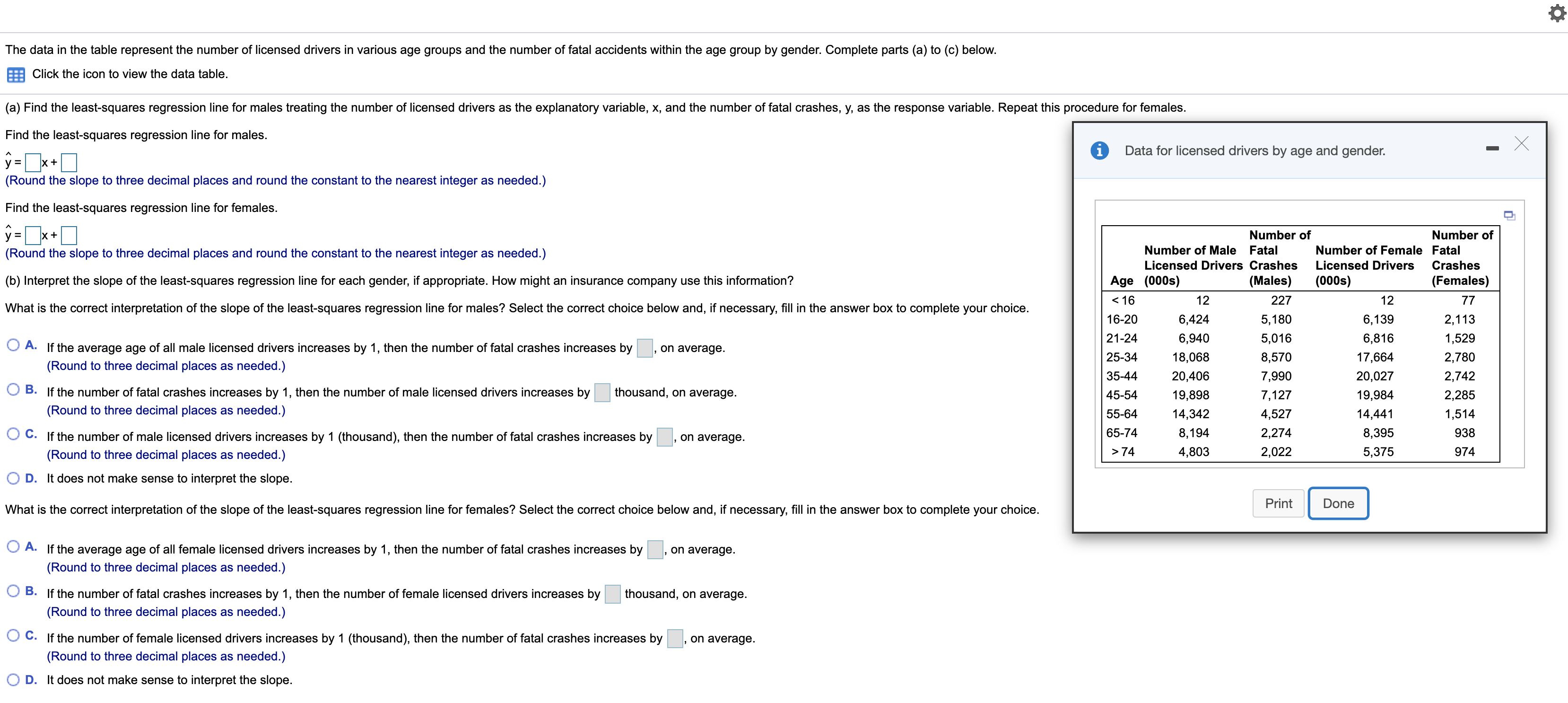The data in the table represent the number of licensed drivers in various age groups and the number of fatal accidents within the age group by gender. Complete parts (a) to (c) below. Click the icon to view the data table. (a) Find the least-squares regression line for males treating the number of licensed drivers as the explanatory variable, x, and the number of fatal crashes, y, as the response variable. Repeat this procedure for females. Find the least-squares regression line for males. Data for licensed drivers by age and gender. y = x+ (Round the slope to three decimal places and round the constant to the nearest integer as needed.) Find the least-squares regression line for females. y =x+ Number of Number of (Round the slope to three decimal places and round the constant to the nearest integer as needed.) Number of Male Fatal Number of Female Fatal Licensed Drivers Crashes Licensed Drivers Crashes (b) Interpret the slope of the least-squares regression line for each gender, if appropriate. How might an insurance company use this information? Age (000s) (Males) (000s) (Females) < 16 12 227 12 77 What is the correct interpretation of the slope of the least-squares regression line for males? Select the correct choice below and, if necessary, fill in the answer box to complete your choice. 16-20 6,424 5,180 6,139 2,113 21-24 6,940 5,016 6,816 1,529 O A. If the average age of all male licensed drivers increases by 1, then the number of fatal crashes increases by on average. 25-34 18,068 8,570 17,664 2,780 (Round to three decimal places as needed.) 35-44 20,406 7,990 20,027 2,742 O B. If the number of fatal crashes increases by 1, then the number of male licensed drivers increases by thousand, on average. 45-54 19,898 7,127 19,984 2,285 (Round to three decimal places as needed.) 55-64 14,342 4,527 14,441 1,514 O C. If the number of male licensed drivers increases by 1 (thousand), then the number of fatal crashes increases by on average. 65-74 8,194 2,274 8,395 938 (Round to three decimal places as needed.) > 74 4,803 2,022 5,375 974 O D. It does not make sense to interpret the slope. Print Done What is the correct interpretation of the slope of the least-squares regression line for females? Select the correct choice below and, if necessary, fill in the answer box to complete your choice. O A. If the average age of all female licensed drivers increases by 1, then the number of fatal crashes increases by on average. (Round to three decimal places as needed.) O B. If the number of fatal crashes increases by 1, then the number of female licensed drivers increases by thousand, on average. (Round to three decimal places as needed.)
Correlation
Correlation defines a relationship between two independent variables. It tells the degree to which variables move in relation to each other. When two sets of data are related to each other, there is a correlation between them.
Linear Correlation
A correlation is used to determine the relationships between numerical and categorical variables. In other words, it is an indicator of how things are connected to one another. The correlation analysis is the study of how variables are related.
Regression Analysis
Regression analysis is a statistical method in which it estimates the relationship between a dependent variable and one or more independent variable. In simple terms dependent variable is called as outcome variable and independent variable is called as predictors. Regression analysis is one of the methods to find the trends in data. The independent variable used in Regression analysis is named Predictor variable. It offers data of an associated dependent variable regarding a particular outcome.

Trending now
This is a popular solution!
Learn your way
Includes step-by-step video
Step by step
Solved in 2 steps with 5 images






